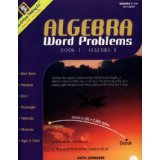These two books are great supplements for pre-algebra through algebra 2. Each book includes teaching directions and detailed solutions. Each of these books was originally published as a number of smaller books on each section topic. Consequently, problems increase in difficulty from beginning to the end of each topic section, so you might use easier activities from a number of sections, coming back and using more-challenging activities at a later time rather than working straight through. The books have 264 and 175 pages respectively.
Both books start with the topic How to Solve Algebra Word Problems. This is a great starting place for most students. This section walks students through strategies to translate word problems into mathematical forms, helps them identify what the problem is asking for, and teaches them to identify what steps are needed. Students are taught to check their solutions, taking time to think about the reasonableness (or unreasonableness) of their answers. From there, you can go on to other topics according to the needs of each student.
Other topics in the Algebra I book:
- Warm-Up: students practice translating word problems into math statements in various situations. E.g. "When Cheryl is twice as old as she was four years ago, she will be one year younger than Bill is now," or "A room is three feet longer than it is wide. What is its area in terms of its width?"
- Ages and Coins
- Mixtures: "To have a mixture of 5% sand, 95% topsoil, how much sand must be added to twenty yards of topsoil?"
- Formulas, Rectangles, D=rt: especially helpful on those troublesome time/rate
- Percents and Work Rates
- Miscellaneous
Algebra II topics:
- How to Solve Algebra Word Problems
- Fun Time: includes some math tricks that might even work for younger students.
- Diophantine Problems: e.g."Jamison bought ham at $3 a pound and cheese balls at $5 each, paying a total of $90. How many of each were bought if Jamison bought at least three times as many pounds of ham as cheese balls?"
- Miscellaneous B-1








